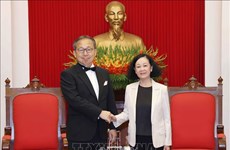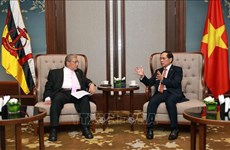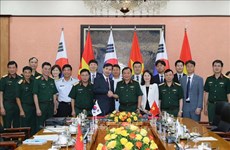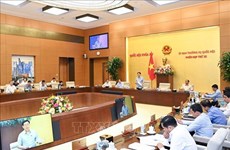Deputy FM stresses need of COC in East Sea
Deputy Foreign Minister Pham Quang Vinh emphasised the need to build a
Code of Conduct (COC) in the East Sea as a more effective tool to ensure
the region’s common goals.
Deputy Foreign Minister Pham Quang Vinh emphasised the need to build a
Code of Conduct (COC) in the East Sea as a more effective tool to ensure
the region’s common goals.
Vinh said this in an interview granted to the press on the results of a recent meeting of senior officials from ASEAN in Hanoi .
The Deputy FM said that the East Sea is a very important area in terms of geo-strategy, security and economics, where there are strategic maritime routes for the region and the world as well.
At the same time, in the area there exist complicated disputes on territorial sovereignty. Therefore, the common goal is to prevent the disputes from escalating and ensure peace, stability, security, maritime safety and freedom in the East Sea .
For this goal, ASEAN and China signed a very important document in 2002, which is the Declaration on Conduct of the Parties in the East Sea (DOC). Over the past 10 years, the DOC not only has reflected the parties’ joint commitment to peace, maritime security and safety, and trust building cooperation in the East Sea , but also has actually created a framework regulating the parties’ conducts.
The most important thing in the declaration is that the parties’ conducts must base on the principle of respecting international laws, especially the 1982 UN Convention on the Law of the Sea (UNCLOS).
However, in the 10-year period, the East Sea has still witnessed many complicated developments threatening regional peace, security and stability, Vinh noted.
“It requires the region to build a tool that can ensure the above-said objective more effectively. That is the COC,” he stressed.
Toward that goal and to manifest ASEAN’s key role for regional peace, security and stability, leaders of ASEAN member countries have decided to carry out internal consultation activities on the COC since November 2011, which will serve as a foundation for the upcoming discussions between ASE AN and China, the diplomat said.
Subsequently, the ASEAN Senior Officials Meeting (SOM ASEAN) has instructed its working group to build a document on ASEAN’s viewpoints on the COC’s main components, he said.
The working group had held seven rounds of consultations before the ASEAN Senior Officials Meeting in Hanoi on June 24-25 reached consensus and completed the document. It will be submitted to the ASE AN Foreign Ministers to decide before starting ASEAN-China negotiations in the coming time.
According to the Deputy Minister, Vietnam , as a coordinator, has made active and constructive contributions to the ASEAN consultation process, especially at the recent SOM ASEAN in Hanoi .
Regarding ASEAN’s viewpoint on the COC’s basic components, Vinh said the general approach is that, the COC will not only inherit the DOC’s positive points but also be upgraded to a higher level on the basis of summarising the 10-year implementation of the DOC in order to meet the requirements of the new situation.
In short, the future COC needs to include the principle of respecting international laws, the UN Charter, the 1982 UNCLOS, the Treaty of Amity and Cooperation in Southeast Asia (TAC) and the DOC.
The COC’s goal should be creating a law-based framework regulating the conducts of the parties in the East Sea in accordance with the above-said principles.
The code must stipulate the obligations and conducts of the parties in the East Sea , which first of all is to work for peace, stability, security, maritime safety and freedom while boosting cooperation in building confidence, preventing disputes from escalating and solving disputes peacefully on the basis of international law and the UNCLOS. At the same time, it should lay stress on the respect for the exclusive economic zones and continental shelves of coastal states under the 1982 UNCLOS.
Furthermore, the COC should include mechanisms to ensure its implementation, including those to supervise implementation, deal with violations and ensure the peaceful settlement of disputes on the basis of international laws, UNCLOS and TAC, he added.
Deputy Minister Vinh noted that the ASEAN document on the COC’s main components is just the viewpoint of ASEAN. The bloc will have to negotiate with the Chinese side on specific issues, he said, adding that this process will be not easy due to the differences between the two sides.
“We think that if all parties share the aspiration for peace, security, stability and cooperation in the East Sea, they should support ASEAN’s viewpoint of building the COC into a tool that effectively contributes to the foregoing common objectives,” Vinh concluded./.
Vinh said this in an interview granted to the press on the results of a recent meeting of senior officials from ASEAN in Hanoi .
The Deputy FM said that the East Sea is a very important area in terms of geo-strategy, security and economics, where there are strategic maritime routes for the region and the world as well.
At the same time, in the area there exist complicated disputes on territorial sovereignty. Therefore, the common goal is to prevent the disputes from escalating and ensure peace, stability, security, maritime safety and freedom in the East Sea .
For this goal, ASEAN and China signed a very important document in 2002, which is the Declaration on Conduct of the Parties in the East Sea (DOC). Over the past 10 years, the DOC not only has reflected the parties’ joint commitment to peace, maritime security and safety, and trust building cooperation in the East Sea , but also has actually created a framework regulating the parties’ conducts.
The most important thing in the declaration is that the parties’ conducts must base on the principle of respecting international laws, especially the 1982 UN Convention on the Law of the Sea (UNCLOS).
However, in the 10-year period, the East Sea has still witnessed many complicated developments threatening regional peace, security and stability, Vinh noted.
“It requires the region to build a tool that can ensure the above-said objective more effectively. That is the COC,” he stressed.
Toward that goal and to manifest ASEAN’s key role for regional peace, security and stability, leaders of ASEAN member countries have decided to carry out internal consultation activities on the COC since November 2011, which will serve as a foundation for the upcoming discussions between ASE AN and China, the diplomat said.
Subsequently, the ASEAN Senior Officials Meeting (SOM ASEAN) has instructed its working group to build a document on ASEAN’s viewpoints on the COC’s main components, he said.
The working group had held seven rounds of consultations before the ASEAN Senior Officials Meeting in Hanoi on June 24-25 reached consensus and completed the document. It will be submitted to the ASE AN Foreign Ministers to decide before starting ASEAN-China negotiations in the coming time.
According to the Deputy Minister, Vietnam , as a coordinator, has made active and constructive contributions to the ASEAN consultation process, especially at the recent SOM ASEAN in Hanoi .
Regarding ASEAN’s viewpoint on the COC’s basic components, Vinh said the general approach is that, the COC will not only inherit the DOC’s positive points but also be upgraded to a higher level on the basis of summarising the 10-year implementation of the DOC in order to meet the requirements of the new situation.
In short, the future COC needs to include the principle of respecting international laws, the UN Charter, the 1982 UNCLOS, the Treaty of Amity and Cooperation in Southeast Asia (TAC) and the DOC.
The COC’s goal should be creating a law-based framework regulating the conducts of the parties in the East Sea in accordance with the above-said principles.
The code must stipulate the obligations and conducts of the parties in the East Sea , which first of all is to work for peace, stability, security, maritime safety and freedom while boosting cooperation in building confidence, preventing disputes from escalating and solving disputes peacefully on the basis of international law and the UNCLOS. At the same time, it should lay stress on the respect for the exclusive economic zones and continental shelves of coastal states under the 1982 UNCLOS.
Furthermore, the COC should include mechanisms to ensure its implementation, including those to supervise implementation, deal with violations and ensure the peaceful settlement of disputes on the basis of international laws, UNCLOS and TAC, he added.
Deputy Minister Vinh noted that the ASEAN document on the COC’s main components is just the viewpoint of ASEAN. The bloc will have to negotiate with the Chinese side on specific issues, he said, adding that this process will be not easy due to the differences between the two sides.
“We think that if all parties share the aspiration for peace, security, stability and cooperation in the East Sea, they should support ASEAN’s viewpoint of building the COC into a tool that effectively contributes to the foregoing common objectives,” Vinh concluded./.













